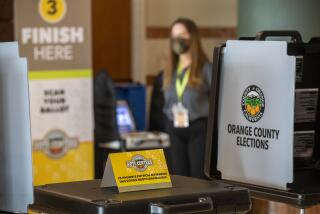It’s time to reform our initiative system
- Share via
Hiram Johnson, the revered reformer and father of the California “citizens” initiative, must be either crying or laughing.
Maybe both.
It was 101 years ago that Gov. Johnson, a former San Francisco graft prosecutor, teamed with other do-gooder Progressives to create California’s system of direct democracy: the initiative, referendum and recall.
That allowed citizens to bypass the special interest-controlled state Capitol and exercise power themselves at the ballot box.
Over the last century, 354 initiatives have qualified for the ballot through signature collecting, and 120 have been passed by voters. That’s a success rate of only 34%, so voters do tend to be discerning, or at least unconvinced when confused.
But Johnson’s ideal of citizen empowerment to fight the moneyed interests has been turned on its head. More and more over the years, California’s initiative system has become a tool of the special interests and a plaything of the mega-rich.
It’s almost unfathomable that $372 million was spent to promote or attack the 11 measures on last week’s state ballot. That figure comes from MapLight, a nonpartisan organization that crunches numbers from the secretary of state.
To put it in perspective, that amount of money could pay for the annual tuitions of 31,000 undergrads at the University of California.
The top 20 donors provided 69% of all initiative funding, MapLight reported.
The most lavish spender was Pasadena civil rights attorney Molly Munger, who poured $44 million into her Proposition 38, which would have raised income taxes mostly to fund schools. Regardless of her largess, Prop. 38 was the biggest loser on the ballot, garnering only 28% of the vote.
The second-biggest donor was Molly’s half brother, Stanford physicist and Republican activist Charles Munger Jr. He spent $37 million on two other losing causes: Prop. 32 to cripple labor unions and the fight against Gov. Jerry Brown’s Prop. 30 tax increase.
So the Munger siblings — children of Warren Buffett’s investment partner, Charles Munger Sr. — kicked in roughly $80 million between them to play the California initiative game this year.
Then there was hedge-fund billionaire Thomas F. Steyer of San Francisco, a Democratic donor and environmentalist. He wrote checks for $30 million on a winner, his Prop. 39, which will close a tax loophole used by out-of-state corporations and fund alternative energy retrofitting.
The Mungers and Steyer probably aren’t the sort of ordinary citizens Johnson had in mind when he championed the initiative system.
Neither is it likely that he anticipated special interests using the system as their own branch of government.
Brown turned to unions to foot most of the bill for his tax increase. In all, Map-Light reports, he raised about $70 million, primarily from special interests. Think a few might have their hooks into him? You’d have to be awfully naïve to think not.
So what can be done about all this? Practically nothing — not as long as the U.S. Supreme Court continues to equate money with speech, not property.
However, one of this year’s most cynical and arrogant abuses of direct democracy could be corrected by the Legislature. It could require complete disclosure of funding sources and ban the use of laundered money in initiative campaigns.
Actually, the obscure Arizona outfit that dumped $11 million of laundered money into the pro-32 and anti-30 campaigns wound up sullying its own causes. It gave Brown a sleazy target to shoot at and raised suspicions among voters: If these shadowy donors had nothing to hide, why were they hiding?
“Voters need to be able to identify who is supporting or opposing a measure,” says state Senate leader Darrell Steinberg (D-Sacramento).
Full disclosure is one piece of a hefty package of initiative reforms that Steinberg plans to introduce in the next Legislature. Most of his proposals would need approval from voters.
Steinberg also would:
• Allow the Legislature to place a tax increase on the ballot with a simple majority vote if lawmakers didn’t want to hike taxes on their own. Now it requires a two-thirds vote, which Brown failed to attain last year. That forced him to go the initiative route.
“At a minimum, a governor who wins election overwhelmingly should be able to place his version of a tax increase on the ballot with a majority vote of the Legislature,” Steinberg says.
Brown wound up spending $8 million in special-interest money to collect signatures for the initiative.
• Bring back the “indirect initiative” that Johnson pioneered but was scuttled in a misguided mid-1960s constitutional revision. Under that system, the Legislature could get a crack at altering an initiative before it went on the ballot. Sponsors could accept or reject the lawmakers’ work.
This would insert some representative democracy into the initiative system, Steinberg says. “At least we’d have committee hearings, public testimony and the press watching our moves as opposed to just somebody with a big checkbook drafting an initiative however they choose.”
• Allow the Legislature to amend or repeal a statutory initiative after 10 years. About two dozen states permit this. “Needs and priorities change,” Steinberg says.
Note to Prop. 13 worshipers: Relax. That property tax limitation is a constitutional amendment and would be protected.
John Matsusaka, president of the Initiative and Referendum Institute at USC, calls California’s initiative system “a net plus,” because “there are times when elected officials aren’t doing what voters want them to, and they ought to.”
But he adds: “Any reasonable person is going to be uncomfortable watching the vast amounts of money being spent, the extreme influence of interest groups and the distorted messages.”
We’re in desperate need of a 21st century Hiram Johnson.
More to Read
Sign up for Essential California
The most important California stories and recommendations in your inbox every morning.
You may occasionally receive promotional content from the Los Angeles Times.














